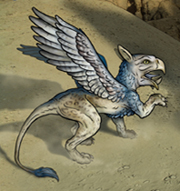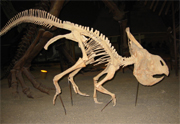
 In
the works of Homer, Herodotus, Hesiod, Pliny and others, the Greeks and Romans
recorded stories of large beasts such as griffins, cyclopes and giants three
times the size of men. They and other early people also wrote of angry underground
gods who caused the earth to shake, water gods or massive sea serpents who caused
the sea to rise up and swallow the land, and gods who threw fire and ash into
the air.
In
the works of Homer, Herodotus, Hesiod, Pliny and others, the Greeks and Romans
recorded stories of large beasts such as griffins, cyclopes and giants three
times the size of men. They and other early people also wrote of angry underground
gods who caused the earth to shake, water gods or massive sea serpents who caused
the sea to rise up and swallow the land, and gods who threw fire and ash into
the air. Far left: The Greeks wrote of the griffin, a mythical beast with the body of a lion and the head and wings of an eagle that lived in the mountains far to the east of Greece (near the present-day Gobi Desert) and fiercely guarded its nests near gold deposits. Left: Skeletons of Protoceratops — a beaked dinosaur the size of a lion — found in the Gobi Desert match descriptions of the griffin, leading to speculation that the griffin story may have simply been how the ancient Greeks interpreted the dinosaur bones. Left image by Ed Heck and Daniel Loxton, courtesy of Adrienne Mayor; right image, Adrienne Mayor.
Recently, scientists have begun looking at these tales with new eyes, wondering if the mythological tales could have been based on fact, rather than the wild imaginations of ancient cultures. Some geologists are trying to draw such connections in an emerging field called “geomythology.”
Myths may not have been “tall tales, but rather the interpretation of people at the time,” says Brent Breithaupt, a paleontologist and director of the University of Wyoming Geological Museum in Laramie. Like scientists, early people would seek explanations for everyday events and creatures, including unusual fossil remains.
Indeed, says classical folklorist Adrienne Mayor, many myths “seem too real to simply be made up. They sound more like attempts to describe something the people actually encountered.”
Take the case of the griffin: an animal the ancient Greeks described as having the body of a lion, and the beak, wings and talons of an eagle. The griffin supposedly lived in distant mountains, building its nest in the desert near sources of gold, which it guarded ferociously. The description, Mayor says, “sounds kind of like dinosaurs.”
To confirm her suspicion, Mayor turned to the deserts of Mongolia and northwestern China, a gold-rich area through which traders traveled on their way to and from Greece and where the griffin story arose. These deserts are chock-full of dinosaur remains — especially Protoceratops, which is a beaked dinosaur about the size of a lion, and Psittacosaurus, a smaller beaked dinosaur.
The area was a vast dinosaur nesting ground, with well-preserved eggs and hatchlings of both dinosaurs, and gold flakes that continually erode out of the surrounding mountains, Mayor says. Thus, “the finding of bonebeds of either creature could have inspired the idea of fierce four-legged creatures with beaks guarding the approaches to gold,” she says. Connecting dinosaurs with griffins led to more questions about the origins of other mythological creatures, as Mayor discusses in her books, The First Fossil Hunters: Paleontology in Greek and Roman Times and Fossil Legends of the First Americans.
While Mayor was visiting a museum on Samos, a small Greek island off the coast of Turkey, a farmer brought in a bone “that was as big as I was,” Mayor says. It was a mastodon thigh bone, and the landscape was littered with them.
“I realized then that people had been finding these bones since antiquity,” she says. The bones were too big to be easily ignored: “People then would have looked for an explanation, much as people today would.” So Mayor began searching for ancient records of fossil finds.
She found 100 accounts by 30 different authors, from Herodotus to Saint Augustine, that described many different locations of fossils, most likely mammoths, mastodons, wooly rhinoceroses, Deinotherium (which somewhat resemble giant elephants) and other extinct animals. Mammoth femurs are three times the size of an average human femur and to the casual observer the limb bones look remarkably similar — perhaps leading to the idea that giants once populated Earth. Similarly, Deinotherium skulls have giant holes where their nasal cavities were, perhaps inspiring the myth of the cyclopes — fierce giants with a single eye.
Mayor mapped the places where ancient Greek myths said that the gods had killed multitudes of giants, and where giant bones were discovered. Then, with the help of several paleontologists, she also surveyed known fossil deposits. The ancient finds almost all directly corresponded to locations where large mammalian fossils have been found in abundance.
“Is it a coincidence?” Breithaupt asks. “Perhaps. But there are fossils, people and stories all in the same location and it’s quite possible that they all relate.” Science and history are both subject to interpretation, he says, and people throughout the ages have been changing interpretations based on new information.
Many myths probably can be explained by science today, Breithaupt says, but it is important to realize that there is much more research to be done in this field. Indeed, Mayor says she has heard stories from paleontologists and geologists regarding possible connections between myths and geology, from places as varied as ancient Mesopotamia, Australia, China, South America and the American West. Some geomythology connections are more tenuous than others, says Susan Hough, a seismologist at the U.S. Geological Survey in Pasadena, Calif. It may be easier to make a case for a dinosaur connection to griffins than to prove that a tsunami sank Atlantis, she says, if Atlantis ever existed.
Still, many geologists have sought these connections for everything from earthquakes in Mesopotamia leading to tales of the destruction of the biblical walls of Jericho, to a volcanic eruption on Santorini in Greece providing the basis for Hesiod’s battle of the Titans. Geomythology is “very interesting work,” Hough says, but many scientists caution that they would not use their geomythology research to obtain tenure.
The work is still “a good way to bring science to nonscientists,” says Jeffrey Tepper, an igneous petrologist at the University of Puget Sound in Washington, who has taught geomythology classes. It is an interesting topic open to broad discussions and interpretations. And it seems likely that the creation of many myths and mythological creatures might have been how people made sense of the world around them, he says.
“Even today, people find comfort in being able to explain things, that they’re not random. Myths have an explanatory goal, as does science.”

